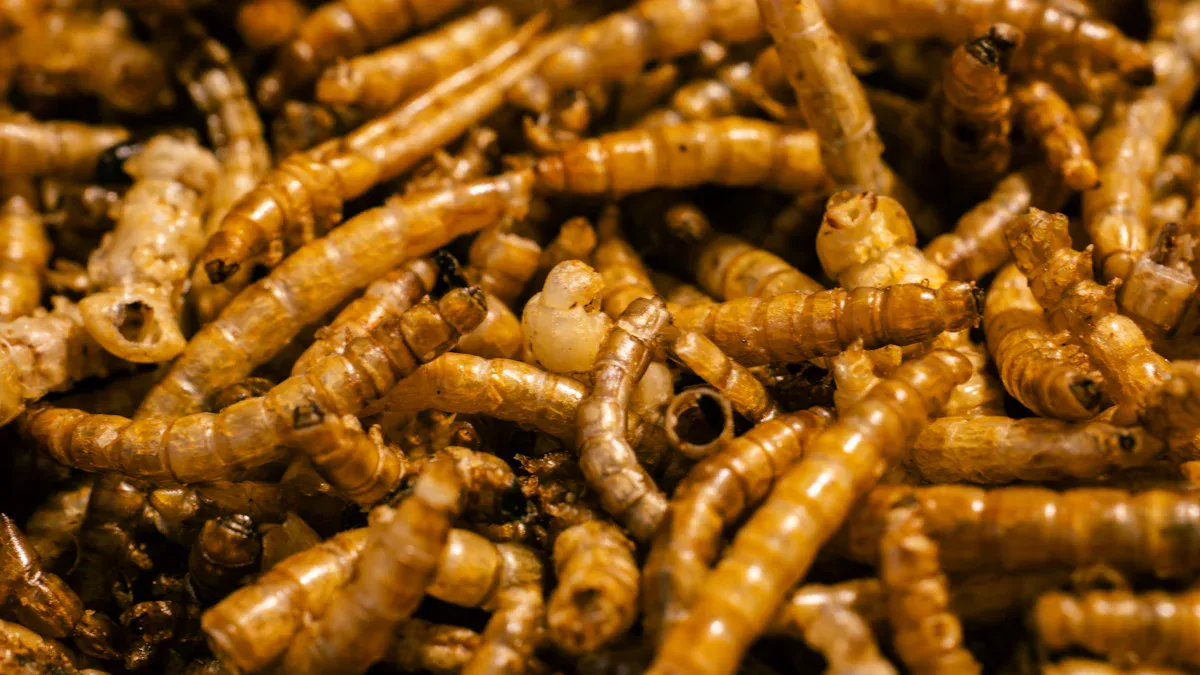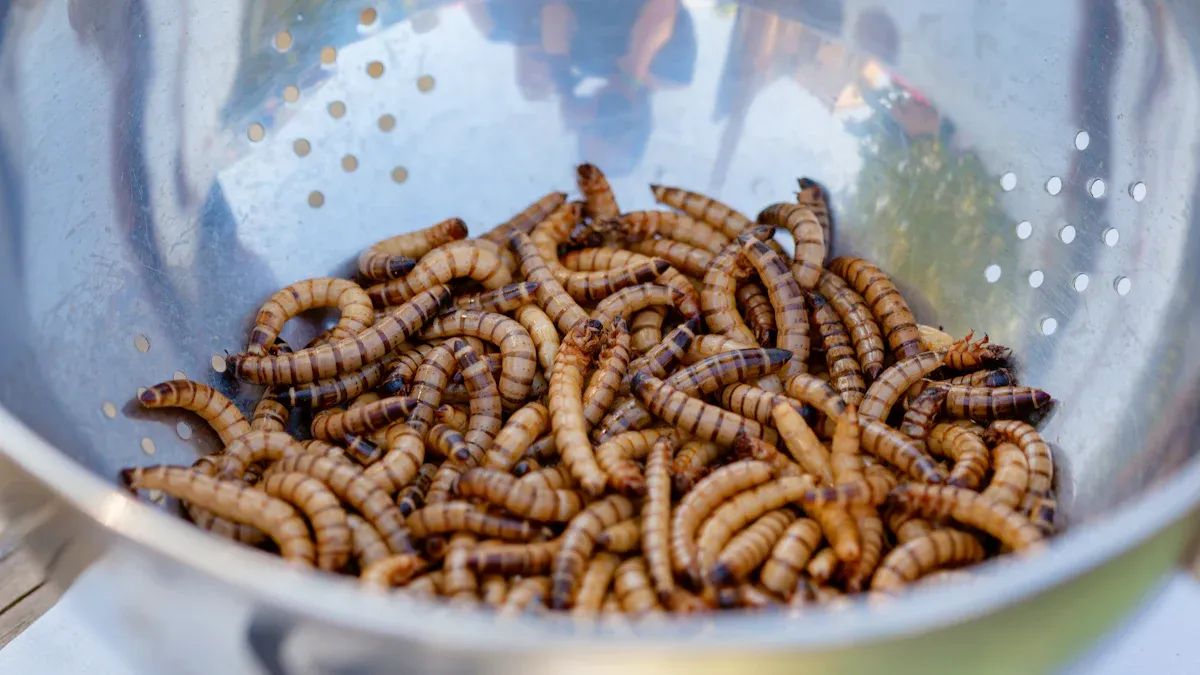
Fish thrive on a diet packed with nutrition, and dried mealworms for fish deliver just that. These tiny powerhouses brim with proteins, essential fatty acids, and digestible amino acids. Studies reveal that mealworm-based diets improve growth and immune health in species like Mandarin fish. Plus, they’re eco-friendly! Producing mealworms requires significantly less water and land compared to traditional livestock, making them a sustainable choice for fishkeepers.
Key Takeaways
- Dried mealworms give fish lots of protein and healthy fats. This helps them grow and stay strong.
- Feeding dried mealworms 2-3 times a week keeps fish healthy. It avoids giving them too much fat.
- Mixing dried mealworms with other fish food makes meals better. This helps fish stay active and healthy.
Nutritional Profile of Dried Mealworms for Fish
Protein and Essential Fatty Acids
Protein is the building block of life, and dried mealworms for fish deliver it in abundance. These little larvae pack a protein punch, with levels ranging from 36.3% to 74.1% on a dry matter basis. Studies show that mealworms reared on commercial oat feed and wheat germ contain protein levels between 63.3% and 68.9%, making them a reliable source for fish nutrition. Essential fatty acids, though not quantified in detail, are present in mealworms and contribute to healthy cell membranes and energy production in fish.
Fun Fact: Mealworms are comparable to fishmeal in terms of essential amino acids, making them a great alternative for fish diets.
A study on Atlantic salmon diets revealed that replacing fishmeal with mealworm meals maintained growth performance and health parameters. This highlights the potential of mealworms as a sustainable protein source for aquatic life.
Vitamins and Minerals for Fish Health
Dried mealworms don’t just stop at protein; they also provide a variety of vitamins and minerals that support fish health. Calcium, though relatively low in mealworms, plays a vital role in bone development and metabolic functions. Other nutrients like ash and moisture contribute to a balanced diet, ensuring fish stay active and vibrant.
Tip: Pair dried mealworms with other nutrient-rich fish foods to create a well-rounded diet.
Mealworms also contain essential amino acids, which are crucial for tissue repair and growth. These nutrients help fish maintain their energy levels and recover quickly from stress or illness.
Balanced Energy Source with Low Fat
Mealworms offer a balanced energy source that supports fish without overloading them with fat. Their crude fat content ranges from 25% to 35%, which is lower than many conventional fish feeds. This makes them ideal for species that require moderate fat levels for optimal health.
Mealworms also shine in terms of energy efficiency. Producing them requires less land and water compared to traditional livestock, and they generate fewer greenhouse gases. This eco-friendly aspect makes them a sustainable choice for fishkeepers who care about the environment.
Note: Mealworms produce less ammonia than livestock, reducing the environmental impact of fish farming.
By incorporating dried mealworms into fish diets, aquarists can provide their pets with a nutritious, energy-efficient food source that promotes health and happiness.
Benefits of Dried Mealworms for Fish
Promoting Growth and Development
Dried mealworms for fish are a powerhouse of nutrients that support growth and development. Their high protein content provides the essential building blocks for muscle and tissue formation. Studies show that the nutritional value of mealworms varies by stage. For example:
- Larvae have higher protein levels, making them ideal for young, growing fish.
- Pupae contain more fat, which can be beneficial for energy needs.
| Study Focus | Fish Species | Findings |
|---|---|---|
| Mealworms as feed | African catfish (Clarias gariepinus) | Reduced feed intake but increased weight gain with 50%-100% live mealworms. |
| Cricket meal substitution | African catfish (Clarias gariepinus) | Improved body weight gain and growth rate with 100% cricket meal. |
These findings highlight how mealworms can enhance growth when included in fish diets.
Boosting Immune Function
A strong immune system is vital for fish to thrive. Dried mealworms contain essential fatty acids and amino acids that help fish fight off diseases. These nutrients strengthen cell membranes and improve overall resilience. Fish fed on insect-based diets, like black soldier fly larvae, have shown increased gut microbiota diversity. This diversity plays a key role in boosting immunity and reducing the risk of infections.
Tip: A healthy gut means a healthier fish!
Enhancing Reproductive Health and Vitality
Reproductive health is another area where dried mealworms shine. Their balanced energy content and nutrient profile support hormone production and egg development. Fish with access to high-quality proteins and fats often display better breeding success and vibrant offspring. Including mealworms in the diet can lead to healthier, more active fish populations.
How to Feed Dried Mealworms to Fish

Selecting High-Quality Mealworm Products
Choosing the right dried mealworms for fish is essential for their health and well-being. High-quality mealworms should be free from contaminants and processed under strict safety standards. Look for products that are sourced sustainably, as mealworms grown on organic waste are both eco-friendly and nutritious.
When assessing quality, consider these key factors:
- Nutritional Value: Mealworms are rich in protein and essential amino acids, making them an excellent addition to fish diets.
- Testing Standards: Reliable brands often use methods like Soxhlet extraction to measure crude fat content and oxygen bomb calorimeters to determine energy levels.
- Growth Conditions: Mealworms thrive on high-protein diets, but not all feeds are equal. For instance, while soya meal contains 42.4% protein, it has a low efficiency in promoting growth.
By selecting mealworms from reputable sources, fishkeepers can ensure their pets receive the best possible nutrition.
Tip: Always check the packaging for certifications and nutritional information to guarantee product quality.
Determining Feeding Frequency and Portions
Feeding dried mealworms to fish requires careful planning to avoid overfeeding or digestive issues. Start by offering small portions and observe how much your fish consume within a few minutes. Gradually adjust the quantity based on their appetite and size.
Experts recommend feeding dried mealworms two to three times a week. This frequency provides a balanced diet without overwhelming their digestive systems. Remember, mealworms should complement other foods rather than serve as the sole source of nutrition.
Here’s a quick guide to get started:
- Frequency: 2-3 times per week.
- Portion Size: Begin with small amounts and increase gradually.
- Observation: Monitor fish behavior and adjust portions as needed.
Note: Overfeeding can lead to water quality issues, so always remove uneaten food promptly.
Combining Mealworms with Other Fish Foods
Dried mealworms for fish work best when paired with other nutrient-rich foods. Combining them with pellets, flakes, or live foods creates a balanced diet that meets all nutritional needs. This approach not only enhances growth but also boosts immune function and overall vitality.
Research highlights the benefits of blending mealworms with other feeds:
- Growth Performance: Studies like Su et al. (2017) found that mealworm-based diets improve growth and disease resistance in yellow catfish.
- Immune Response: Henry et al. (2018a) showed that replacing fishmeal with mealworms enhances immune function in rainbow trout.
- Sustainability: Using mealworms reduces reliance on traditional fishmeal, promoting eco-friendly aquaculture.
| Study | Findings |
|---|---|
| Su et al. (2017) | Mealworms enhance growth, immune response, and disease resistance. |
| Henry et al. (2018a) | Improved innate immune response and antioxidant enzyme levels. |
| Henry et al. (2018b) | Positive immune responses in European sea bass fed mealworm diets. |
By mixing mealworms with other foods, fishkeepers can provide a varied and sustainable diet that supports long-term health.
Pro Tip: Rotate different food types to keep your fish engaged and ensure they receive a wide range of nutrients.
Precautions When Using Dried Mealworms for Fish
Avoiding Overfeeding and Digestive Issues
Feeding fish dried mealworms can be exciting, but portion control is key. Overfeeding often leads to uneaten food sinking to the bottom, which can pollute the water. This not only affects water quality but also stresses the fish. To avoid this, fishkeepers should observe how much their fish consume within a few minutes. Any leftovers should be removed promptly.
Digestive issues can also arise if fish are fed too many mealworms at once. While mealworms are nutritious, they should not replace a balanced diet. Mixing them with other foods ensures fish get all the nutrients they need without overloading their systems.
Tip: Start with small portions and adjust based on your fish’s appetite and behavior.
Ensuring Product Safety and Freshness
High-quality dried mealworms are essential for fish health. Proper storage and processing methods play a big role in maintaining their safety and freshness. Research highlights several effective quality control measures:
| Quality Control Measure | Findings | Implications |
|---|---|---|
| Fermentation | Microbial counts of fermented pastes were below permissible limits, indicating safety for consumption. | Fermentation can enhance safety and shelf life of mealworms. |
| Refrigeration | Blanched mealworms can be stored refrigerated for 10-12 days without spoilage. | Refrigeration is effective for short-term storage of processed mealworms. |
| Use of Preservatives | Fermentation may prevent the growth of pathogens, though further research is needed. | Potential for safer mealworm products through fermentation. |
Fishkeepers should always check packaging for expiration dates and certifications. Storing mealworms in a cool, dry place also helps preserve their quality.
Considering Fish Species and Dietary Needs
Not all fish have the same dietary requirements. Carnivorous species benefit most from the high protein content in mealworms, while herbivorous fish may require additional plant-based foods. Understanding the specific needs of each species ensures they thrive.
Some fish may also prefer smaller mealworm pieces. Crushing or breaking them into smaller bits can make them easier to eat, especially for smaller fish. Observing how fish respond to mealworms helps fishkeepers tailor their feeding approach.
Pro Tip: Research your fish species to create a diet that matches their natural feeding habits.
Dried mealworms offer fish a nutritious, sustainable, and energy-packed food source. They boost growth, strengthen immunity, and enhance vitality. Fishkeepers can feel confident knowing they’re providing a balanced diet that promotes health and happiness.
Why wait? Try dried mealworms today and watch your fish thrive like never before!
Article by Felix
FAQ
How often should dried mealworms for fish be fed?
Fishkeepers can feed dried mealworms two to three times a week. This frequency ensures a balanced diet without overwhelming the fish’s digestive system.
Can all fish eat dried mealworms for fish?
Most carnivorous and omnivorous fish enjoy dried mealworms. However, herbivorous species may need additional plant-based foods to meet their dietary requirements.
Are dried mealworms for fish safe to store?
Yes, they are safe when stored in a cool, dry place. Always check the packaging for expiration dates and certifications to ensure freshness.


